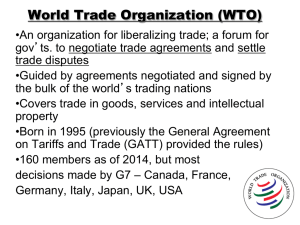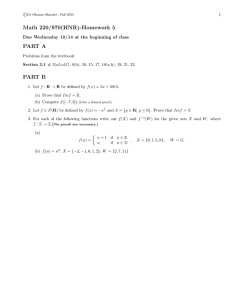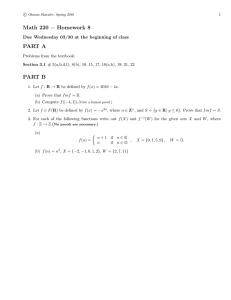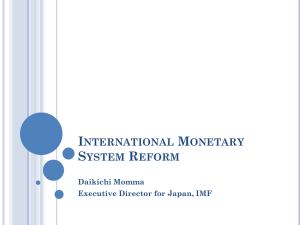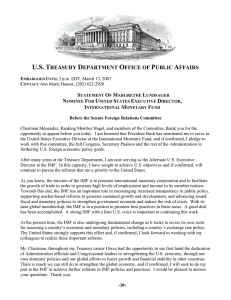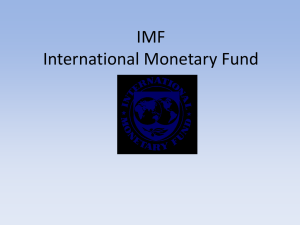Macro-Governance and the Great Game of International Monetary Reform
advertisement
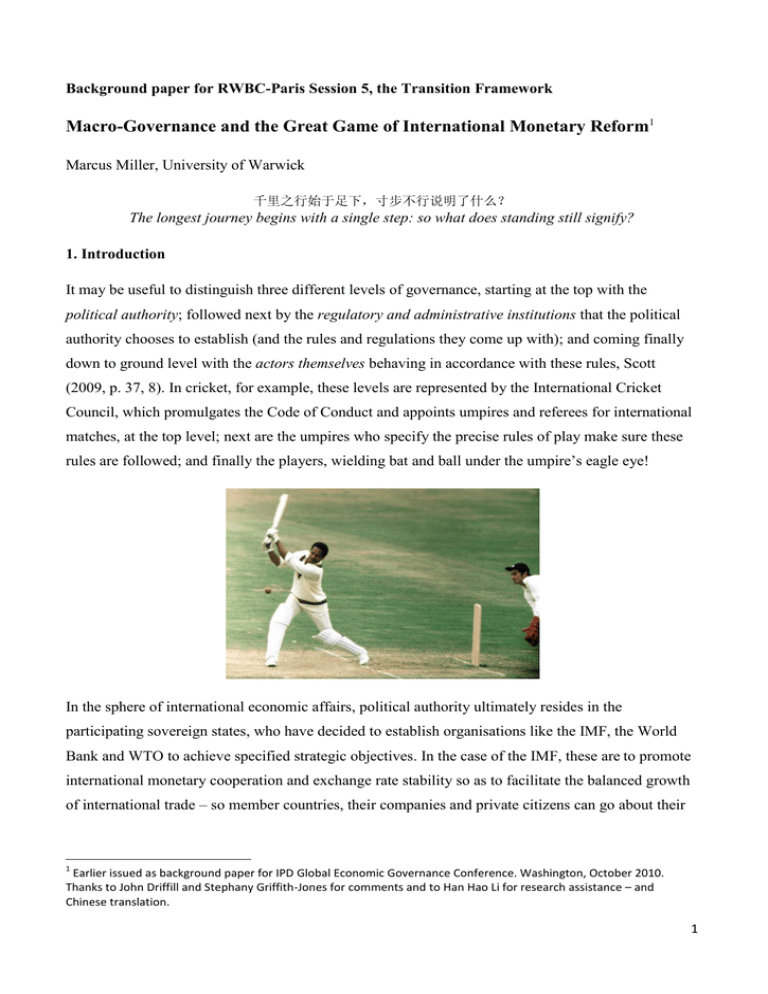
Background paper for RWBC-Paris Session 5, the Transition Framework Macro-Governance and the Great Game of International Monetary Reform1 Marcus Miller, University of Warwick 千里之行始于足下,寸步不行说明了什么? The longest journey begins with a single step: so what does standing still signify? 1. Introduction It may be useful to distinguish three different levels of governance, starting at the top with the political authority; followed next by the regulatory and administrative institutions that the political authority chooses to establish (and the rules and regulations they come up with); and coming finally down to ground level with the actors themselves behaving in accordance with these rules, Scott (2009, p. 37, 8). In cricket, for example, these levels are represented by the International Cricket Council, which promulgates the Code of Conduct and appoints umpires and referees for international matches, at the top level; next are the umpires who specify the precise rules of play make sure these rules are followed; and finally the players, wielding bat and ball under the umpire‘s eagle eye! In the sphere of international economic affairs, political authority ultimately resides in the participating sovereign states, who have decided to establish organisations like the IMF, the World Bank and WTO to achieve specified strategic objectives. In the case of the IMF, these are to promote international monetary cooperation and exchange rate stability so as to facilitate the balanced growth of international trade – so member countries, their companies and private citizens can go about their 1 Earlier issued as background paper for IPD Global Economic Governance Conference. Washington, October 2010. Thanks to John Driffill and Stephany Griffith-Jones for comments and to Han Hao Li for research assistance – and Chinese translation. 1 business according to the rules of the regime that has been established, subject to IMF surveillance and financial assistance where necessary. Arrangements that may have been clear and acceptable when these institutions were first set up after WWII have come to be challenged, however. Over time, as output and trade have grown apace, Emerging Market countries (EMs) have become much more prominent players in the world economy; but the IMF has not expanded in commensurate fashion. In their political-economic analysis of the IMF as a credit Union, Irwin et al. (2008) suggest one reason: that the Fund‘s existing lending framework is well suited to a world in which its members have homogeneous interests; but with heterogeneity, the Fund is increasingly unlikely to provide financing on a sufficient scale to meet the demand of higher-risk members, leading them to rely more heavily on self insurance.‘ Dissatisfaction with the operation of the IMF became acute with increased globalization and the onset of financial crisis in emerging markets. When the Sudden Stop in capital flows to South East Asia in 1997/8 led to severe economic instability, IMF policies of providing financial support subject to tough conditionality (of high interest rates and fiscal tightening) were widely seen as ill-designed for capital market crisis. (Significantly, India and China, who maintained controls on capital flows, escaped the crisis.) As a result, the IMF lost the trust of many EM countries, and ‗its big fee-paying clients such as Korea, Russia, Brazil and Argentina deserted it in droves, preferring to take more expensive loans elsewhere.‘ Woods (2010). As Ngaire Woods goes on to note, ‗The old financing model of the IMF made the institution reliant on income from its emerging economy members which borrowed from it in a crisis. Yet this did not give borrowing members power.‘ Indeed, it seemed to provide a perverse incentive for the IMF – giving rewards for mission failure! Exit from the IMF ambit is one response. Another is to co-operate only on condition of systemic reform. In the immediate aftermath of the recent global financial crisis for example, China, Brazil and India refused to join and participate in the New Arrangement to Borrow until more substantial reform were undertaken in the IMF‘s governance and arrangements. Later, at the Pittsburgh summit, the BRICs did agreed to participate in the NAB but only in exchange for quota reform of the IMF - a shift of 5% of the voting power, in the quota review to be completed by January 2011. Could something similar be happening with respect to reform of the International Monetary System (IMS) as a whole – with the persistence of issues like global imbalances reflecting unhappiness with 2 the current rules of the game? If so, what are the alternatives? Before discussing this interpretation of the current state of play, we briefly outline the emergence of the G-20 as an alternative to G7 for discussing reform of the international monetary system. 2. Emergence and achievements of G-20. As Ngaire Woods (2010) notes: ‗The amassing of foreign exchange reserves by emerging economies in the wake of East Asian crisis of 1997 began in large part to ensure ‗financial independence‘ in the event of adverse developments in a country‘s external position. The fallout of IMF‘s engagement in Asia during the 1997 crisis was dramatic. It greatly magnified the ‗stigma‘ associated with assistance from the IMF… (and) swept away the political acceptability of any assistance from the IMF should an external shock hit a country.‘ Along with the accumulation of foreign exchange reserves came the setting up in 1999 of the G20 (a group of finance ministers and central bank governors consisting of 19 countries plus the EU) as a forum for debating the reform of the international monetary architecture in which the interests of EM countries would be more obviously taken into account than in the existing G7. Ironically enough, the value of having such a broader-based group became most apparent after the storm-centre moved from the EM to the so-called Advanced Economies in 2007/8 – a trial by fire when the G20, with its balanced membership of developed and developing countries, helped the world deal effectively global financial and economic crisis. At the first summit in Washington DC in November 2008, for example, the members ‗agreed a series of measures and a joint Action Plan for dealing with the crisis, including measures to reinvigorate their own economies (without damaging global trade), to regulate global finance, to assist the poorest countries affected by the crisis and to reform global institutions.‘ Ngaire Woods (2010). This was only the first of several meetings for the G20 - initially twice a year, in the future, annually. Highlights are indicated in table 1 below, but it may be worth reporting some developments in more detail. 3 Table 1 Summit meetings held in response to 2008-9 crisis: some highlights. Summits Date Key items Washington Nov 2008 A joint Action Plan to deal with the crisis and to implement principles for reform of financial regulation London Apr 2009 Commitment to global monetary and fiscal policy coordination (including +5 trillion of fiscal expansion); $1.1 trillion of additional resources for IFIs and trade finance; Financial Stability Board (to replaces FSF), Pittsburgh Sept 2009 BRICs promised a shift of +5% of voting power for EM Toronto Jun 2010 Framework for ‗Strong sustainable and Balanced Growth‘; Mutual Assessment Process to check collective consistency; +4 trillion Seoul Nov 2010 France 2011 Mexico 2012 To complete quota reform, shifting at least 5% to EMs and DCs Memo items: global GDP 2010 ($62 trillion), The follow-up to the first summit in Washington was in London in April 2009 – a critical time for the world economy suffering a heart attack. ‗A global crisis requires a global solution‘, said the communiqué, noting that the actions taken by fiscal authorities and central bank ‗will constitute the largest fiscal and monetary stimulus and the most comprehensive support programme for the financial sector in modern times.‘ (It was forecast that the ‗unprecedented and concerted fiscal expansion would amount to $5 trillion‘, i.e. around 8% of global GDP.) It was also agreed that over a trillion dollars of additional resources for the world economy were to be channelled through the IFIs. (This was made up of an extra $500 billion of resources available to the IMF in the form of new arrangement to borrow, a new SDR allocation of $250 billion, at least $100 billion of additional lending by the MDBs, and $250 billion of support for trade finance.) ‗Together with the measures we have each taken nationally, this constitutes a global plan for recovery on an unprecedented scale.‘ 4 Earlier this year, the G-20 at Toronto in June 2010 considered the results of the Mutual Assessment Process (MAP). In the absence of coordinated global response, it was noted, global output is likely to remain below its pre-crisis trend. But the IMF and World Bank estimated2 that with improved policy response, global output could be raised by over 5%. As a credible exit strategy from action taken to support financial sector and global demand, principles for fiscal consolidation in Advanced Economies were also agreed, as were and steps to promote financial sector stability. In what may be an indication of topics to be tackled at the forthcoming G-20 summit in Seoul, Dominique Strauss-Kahn (2010) has identified two key issues: first, the imperfections of the system of volatile capital flows, where the balance of adjustment is asymmetric (falling more heavily on deficit, non-reserve-issuing countries) and there exists only a narrow range of reserve assets. The second issue is the massive reserve accumulation (tripling in a decade) that has occurred as a consequence of these imperfections – and the aggregate deflationary impact that may emerge as many countries aim at current account surpluses. Much has been clearly achieved by the G-20 summit meetings so far: by coordinating action and preventing protection, they may indeed have been instrumental in saving the world from sliding into a second Great Depression! In the assessment of Ngaire Woods (2010): ‗The creation of the leaders-level G-20 means that a wider group of countries has engaged in shaping the agenda of global institutions. The new G20 has met and designed action plans with speed. The winner among multilateral institutions has been the IMF, thrust centre stage with approximately $1 trillion resources for the purpose of dealing with the crisis. The IMF has been tasked with lending to emerging economies to prevent financial crisis, fostering cooperation that might prevent a future crisis and assisting poor countries affected by the crisis… Not achieved is a transformation in relations with the major emerging economies such that the IMF would be positioned to address the global imbalances, to set new multilateral rules, to operate as an alternative to self-insurance or indeed to provide a more multilateral response to the development emergency. There is very little (beyond rhetoric) of a multilateral response to poorer countries affected by the crisis.‘ This last maybe no co-incidence: after all, low income, small countries are not in the G20. 3. The game of reform How to avoid global imbalances? The US policy response to excess savings in Asia was to engineer reflation. But other policy packages have been proposed as alternatives that would reduce global imbalances, e.g. ‗tighter fiscal policy and exchange rate depreciation of the US, and looser fiscal policy and exchange rate appreciation in the surplus countries‘, Joshi (2010, pp 77). Coming up with 2 See IMF (2010). 5 technical solutions of this sort is all very well; but is their implementation incentive compatible? Will surplus countries be willing to cooperate if doing so is seen as accepting rules that failed to prevent crisis? Maybe not. As Jim O‘Neil (2010) - the man who coined the BRICs acronym - remarks, ‗it could be that China wants to sit back now, especially as a G20 member, and think afresh after the crisis about how the world monetary system might evolve better, with fewer unpredictable, chaotic financial movements occurring. Until then, China may not want fresh movement of their currency adding to their problems.‘ In 2009 the Governor of the Central Bank of China, Zhou Xiaochuan, suggested a broader role for the Special Drawing Right (SDR), as an international reserve currency. In the paper cited, Jim O‘Neill suggests that Governor Zhou may have been thinking of the SDR as part of system of managed exchange rates and IMF-created reserves - an alternative to current system of flexible exchange rate with national currencies as reserves (particularly the dollar). The motivation for this could be that the flexible exchange rate system has been associated with global financial crisis - with the biggest losses occurring in those countries like the US and UK, who had ‗been keen supporters of very flexible and free financial markets, including floating exchange rates.‘ Could non-cooperation at the level of macro-economic policy and exchange rate adjustment under the current rules of the game be seen as a way of trying to secure a change in the rules themselves? The Great Game Consider a strategic game played between great powers – a game in which the EU has yet to play a decisive part. In the Status Quo, China pegs its currency against the dollar and runs a low 6 consumption economy (and seems deaf to US rhetoric calling for revaluation of RMB and rebalancing of domestic demand, even though this offers more consumption for its citizens); while the US, reluctant to give up the ‗exorbitant privilege‘ of printing the world‘s money, dismisses any suggestion for an alternative reserve asset. Can this persist as an equilibrium? Assume each player has a choice of two actions, and chooses a best response to the other‘s action. Thus China can either stay with the Status Quo; or Revalue its currency and Rebalance its aggregate demand (in favour of domestic consumption.) The US for its part can either choose to persist with the current floating rate IMS based on the dollar; or to participate in the development of a managed exchange rate system based on SDR, see Table 2. What are the pay-offs to each party? Normalising pay-offs to zero for the Status Quo, assume that China would be happy to Revalue and Rebalance in the context of an SDR-based system (see column 2), but not when this involves perpetuating the dollar based system, (see column 1). The US, on the other hand, may indeed be reluctant to give up the dollar (a loss of 1 unit of welfare), but this could be more than compensated by China agreeing to Revalue and Rebalance demand. Table 2. Actions and notional payoffs in the Great Game Is the US willing to be flexible on reserve regime? Dollar as reserve currency Will China Peg to dollar, 0, 0 co –operate Export surplus ↑ on adjusting Global Imbalances? SDR as reserve currency ← +1, -1 ↓ Revaluation and Rebalancing -1, +3 ← +2,+2 Note: payoffs shown in each cell are for (China, US). One might therefore hope that equilibrium will involve a shift from the current Status Quo in the top left hand corner to a reformed IMS without global imbalances in the bottom right corner. This will, after all, make both parties will be better off. But without coordination and commitment, the Status Quo is the only Nash equilibrium. (This is indicated by the arrows, showing how each party will respond to the other‘s choice of action, which converge on the Status Quo). What is the moral of the tale? It is that – despite the possibility of extra consumption, China will offer reciprocity and flexibility in policy adjustment only if the US and others are willing credibly to 7 redesign the IMS. More broadly, in terms of the ‗levels of governance‘ discussed in the introduction, the BRICs will only agree to play ball if they have a role in drawing up the rules of the game. 4. Alternatives to the dollar based system Where does one go from the Status Quo? Consider three scenarios as in the figure below. Status Quo ‘Business as usual’ Revamped IMF New IMS The first scenario, is a return to ‗Businesses as usual‘, with floating exchange rates and relatively free capital movements, subject to whatever can be achieved through Basel III, and complementary efforts by individual countries (and the EU) to prevent financial crisis. So the dollar remains as the world‘s reserve currency. Second is revamping the IMF along lines suggested by Dominique Strauss-Kahn (2010). Insofar as reserve accumulation reflects the fear of capital flight and financial instability, he argues, the IMF could provide substitute for individual reserve holdings as follows: the IMF could provide better insurance facilities (e.g. improvements to the FCL, a Precautionary Credit Line); support regional financial arrangements; and develop a Multi-Country Swap/Credit Line instrument for systemic crises that liquidity quickly and simultaneously to several countries with strong underlying fundamentals and policies. As for non-precautionary reserve demand, there could be a wider role of Special Drawing Rights: With a value determined in terms of a basket, the SDR diversifies the currency and interest rate risks of its constituent parts. Thus, it has more stable store of value and unit of account attributes. Moving to a more SDR-based system would require: (i) increased supply, (ii) greater liquidity, and (iii) transparent, automatic 8 rules for determination of the currency composition of the SDR basket, which are essential for wider private sector use. For lively and informed discussion of these issues, see the contributions to IPD (2009). The third scenario would embrace these changes but is a lot more ambitious. It could, for example, include a set of reference rates based on current account targets, as proposed by John Williamson (2007), where Countries‘ authorities are forbidden from intervening in order to push the exchange rate too far from what is termed the ―reference rate.‖ It could help a country‘s authorities manage its exchange rate to avoid large misalignments, assist the private sector in forming more dependable expectations of future exchange rates and thus to manage their businesses more efficiently in a world of floating exchange rates, and aid the International Monetary Fund in designing and managing an effective system of multilateral surveillance. In addition, as well as enjoying the liquidity insurance provided by a re-vamped IMF, countries may have recourse to capital controls as when necessary to preserve financial stability. The case for counter-cyclical prudential regulation to manage the effects of boom-bust cycles – as opposed to the pro-cyclical provisions of earlier Basel Accords – has been made by Ocampo (2003) and Griffith-Jones et al. (2009). For outflow controls3 on capital, the Pigovian logic has been supplied by Anton Korinek (2010) as follows: ‗decentralized agents do not internalize that capital outflows are magnified through a systemic feedback cycle of depreciating exchange rates, tightening financial constraints, and declining aggregate demand, akin to Fisher's process of debt deflation.‘ (See Ostry et al. (2010) for a recent IMF survey of capital controls.) In a wider discussion of how to stabilize the capital flows to emerging markets, Williamson (2005) discusses complementary changes to current practices in advanced economy capital markets, and the creation of new financial instruments, e.g. GDP-indexed bonds, which might help to limit foreign currency borrowing by emerging market governance. Rochet (2006) proposes sovereign debt limits for governments who always repay when they can but are myopic – so they always borrow as much as possible without paying attention to the burden of future repayments. Finally, as Dominique Strauss-Kahn has indicated, ‗a new global currency might evolve out of the special drawing right.‘ A new global currency may be necessary to ‗make globalisation work‘, Stiglitz (2006, chapter 9). Note that, insurance companies in London impose so called ‗value adjustments‘ as exit taxes on withdrawals, and of course, many hedge funds ‗gated‘ their depositors and stopped marking to market to keep afloat during the recent crisis: if this is what financial institutions do, why not sovereigns? 3 9 5. Conclusion The vast accumulation of international reserves by EM countries, both as a pre-cautionary cushion and as a side-effect of export-led policy, are symptoms of defects in the International Monetary System. The debate on policy adjustment to handle Global Imbalances must surely take into account the desire by BRIC and other emerging market countries to play a bigger part in the Great Game of resetting the rules. References Griffith-Jones, S, Ocampo, JA and Ortis, A. (2009), ‗Building on the counter-cyclical consensus: A policy agenda‘, High-level Roundtable ―Towards Basel III? Regulating the Banking Sector after the Crisis, Brussels on October 12. IMF (2010), ‗G-20 Mutual Assessment Process—Alternative Policy Scenarios‘, a report by the IMF Staff. IPD (2009), ‗ Towards A World Reserve System‘, Conference at Columbia University, New York, Nov 2009. http://policydialogue.org/events/meetings/towards_a_world_reserve_system_new_york_2009/ Irwin, Gregor & Penalver, Adrian & Salmon, Chris & Taylor, Ashley, 2008. "Dealing with country diversity: challenges for the IMF credit union model," Bank of England working papers 349, Bank of England.Joshi, Joshi, Vijay (2010), ‗Global imbalances and the current crisis‘. In Robert Skidelsky (ed) The Economic Crisis and The State of Economics. London: Centre of Global studies. Korinek, Anton (2010), "Regulating Capital Flows to Emerging Markets: An Externality View", working paper O‘Neil, Jim, (2010), ‗A Twenty-first century International Monetary System: Two Scenarios.‘ In P. Subacchi and J. Driffill (eds.), Beyond the Dollar: Rethinking International System, London: RIIA, pp. 43-45. Ostry, et al. (2010), ‗Capital inflows, the role of controls‘, SPN/10/04. Rochet, Jean-Charles (2006). "Optimal Sovereign Debt: An Analytical Approach," RES Working Papers 4477, Inter-American Development Bank, Research Department. Scott, Bruce (2009) The Concept of Capitalism. New York; Springer. Stiglitz, Joseph (2006), Making Globalization Work, London: Allen Lane (Penguin). Strauss-Khan, Dominique (2010), ‗Concluding remarks‘, High-Level Conference on the International Monetary System, Zurich, May 11, 2010. Williamson, John. (2007). Reference Rates and the International Monetary System. Policy Analyses in International Economics 82. Washington: Peterson Institute for International Economics. Williamson, John (2005), Curbing the boom-bust cycle: Stablizing capital flows to emerging markets, Policy Analyses in International Economics 75, Washington: Peterson Institute for International Economics. Woods, Ngaire (2010), ‗Global Governance after the financial crisis: A New Multilateralism or the Last Grasp of the Great Powers‘, Global Policy 1 (1), pp 51-63. 10
